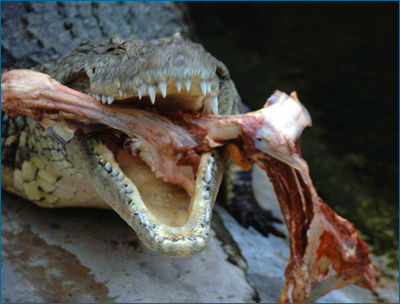Jackson took a direct, experimental approach to distinguishing croc bites from those of mammalian carnivores. He enlisted two crocodile farms in Tanzania that had Nile crocodiles, a species that is thought to be closely related to the ancient species living at Olduvai. He let the Nile crocodiles eat the carcasses of cows and goats under controlled conditions, examined the remains, and compared marks on the bones to those made by hyenas, lions, dogs, and stone tools.

“It was very exciting because crocodiles feed totally differently from mammalian carnivores,” says Jackson. “They are messy eaters.” After latching onto an animal and drowning it, a crocodile will dismember its victim into “bite-size” pieces by rolling it underwater, violently shaking the carcass, and banging it on rocks, marking and fracturing the bones in the process. This feeding behavior often involves two or more crocodiles holding a carcass tight with their teeth and twisting or rolling in opposite directions. Because crocs have small stomachs (and because parts of the animal tend to fly off when it is being thrashed by a crocodile), large sections of the carcass are often left behind nearly untouched.
After the crocs had fed, Jackson collected the remaining bones, cleaned them, and examined and catalogued the marks left on them. While many of the marks made by crocodiles were similar to those made by mammalian carnivores, some were distinct. Crocodiles have pointy, conical teeth with sharp ridges, called carinae, at the front and back. These teeth often (but not always) leave behind impressive punctures and distinctive pits with a deeper gouge running through the center, called bisected marks. Bisected marks are particularly diagnostic of crocodile predation: Jackson hasn’t found any other predator or process that leaves marks quite like these on bones. Crocodiles also sometimes produce curved scratches, called hook-scores, which may reflect their violent feeding behavior. Mammalian carnivores don’t leave behind such marks, so these curved marks also point to crocodile predation.

Of course, not all of the marks were so clear cut. Crocs also inflict deep, thin scratches, deep gouges, and fields of narrowly spaced grooves on bone surfaces. Such marks may be indistinguishable from those made by hominids’ stone tools.
Fortuitously, Jackson found other clues that point to crocodile predation as well. Mammalian carnivores frequently gnaw on bones, but crocodiles do not. Furthermore, crocodiles often leave behind large unbroken bones behind, sometimes still connected to other bones — such as a whole, articulated leg. Mammalian carnivores and hominids, on the other hand, are more thorough feeders, usually breaking bones open to reach the marrow within, a process that leaves behind smaller bone fragments.
Based on his feeding experiments, Jackson assembled a list of characteristic taphonomic clues that point to crocodile predation: punctures, bisected marks, hook-scores, lack of gnawing, and whole, unbroken bones left behind. He further tested these ideas in the field by collecting bones from animals that had been fed upon by wild crocodiles in Serengeti National Park. His observations corroborated his previous work: the bones he observed and the patterns of marks on them were consistent with those he had seen in his study of captive crocodiles feeding on already dead animals. Jackson’s experimental and observational studies showed that one could often distinguish a crocodile attack from the many other ways that an animal might have been killed.1
1Njau, J.K., and R.J. Blumenschine. 2006. A diagnosis of crocodile feeding traces on larger mammal bone, with fossil examples from the Plio-Pleistocene Olduvai Basin, Tanzania. Journal of Human Evolution 50:142-162.
